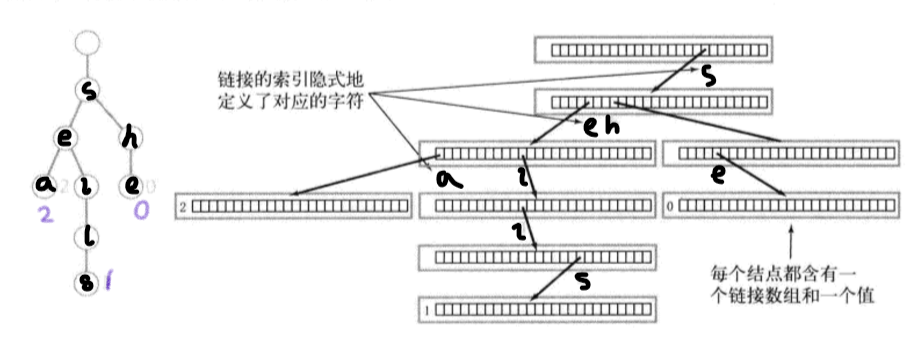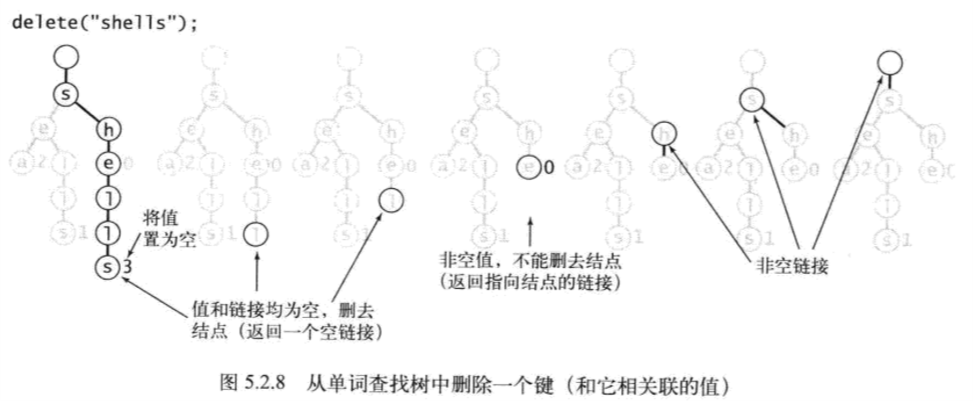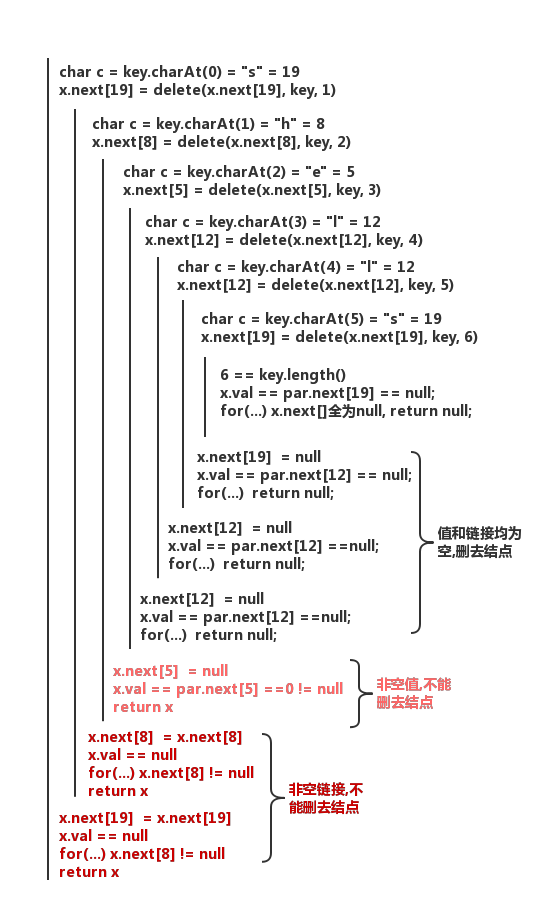算法5.4 单词查找树
以字符串为键的符号表API
public class StringST
| 返回类型 | 方法 | 描述 |
|---|---|---|
| StringST() | 创建符号表 | |
| void | put(String key, Value val) | 插入键值对 |
| Value | get(String key) | key对应值 |
| void | delete(String key) | 删除key以及值 |
| boolean | contains(String key) | 是否含有key的值 |
| boolean | isEmpty() | 符号表是否为空 |
| String | longestPrefixOf(String s) | s前缀中最长的键 |
| Iterable | keysWithPrefix(String s) | 所有以s为前缀的键 |
| Iterable | keysThatMatch(String s) | 所有和s匹配的键 |
| int | size() | 键值对数量 |
| Iterable | keys() | 所有和s匹配的键 |
算法5.4 (R向)单词查找树
- 基本性质
- 将每个键(String)关联值(Value)保存在该键最后一个字母对应结点中
- 值为null的键在符号表中无对应键,存在为了简化单词查找树中的查找
public class TrieST<Value>{private static int R = 256;private Node root;...}
- 查找:从首字母链接开始,到下一个结点对应第二个字母的链接…不断向下,直到键最后一个字母对应结点或遇到空链接
- 键尾字符对应结点值非空—查找命中
- 键尾字符对应结点值为空—未命中,符号表中不存在被查找的键
- 查找结束于空链接—未命中
public void get(String key){Node x = get(root, key, 0);if(x == null) return null;//未找到,返回nullreturn (Value)x.val;}private Node get(Node x, String key, int d){if(x == null) return null;//空链接if(d == key.length()){ return x;}char c = key.charAt(d);//找到第d个字符对应子单词查找树return get(x.next[c], key, d+1);}
- 插入:和BST一致,插入就是先进行查找,直到树中尾字符的结点或空链接
- 先遇到空链接:此时树中无插入结点,则需要为每个字符创建一个新结点将值保存在末尾
- 先遇到尾字符:此时树中已有插入结点,则更新值
public void put(String key, Value val){root = put(root, key, val, 0);}private Node put(Node x, String key, Value val, int d){if(x == null) x = Node();//空链接,创建新结点if(d == key.length()){ x.val = val; return x;}char c = key.charAt(d);//找到第d个字符对应子单词查找树x.next[c] = put(x.next[c], key, val, d+1);return x;}
- 结点的表示
- 每个结点含有R个链接,对应每个可能字符
- 字符和键值隐式的保存:如sea,数据结构中没有”s””e””a”,但通过从根结点到最后结点每段路径的链接位置19->5->1标识
//内部类private static class Node{private Object val;//无法定义泛型数组private Node[] next = new Node[R];}

- 大小:统计树中键的数量
- 即时实现:设置实例变量N,在put()和delete()时更新
- 延时实现:递归遍历所有结点
//递归延时实现:牺牲性能public int size(){ return size(root); }private int size(Node x){if(x == null) return 0;int cnt = 0;if(x.val != null) cnt++;for(char c = 0; c < R; c++)cnt += size(next[c]);return cnt;}
- 查找所有键
- BST中Node有val变量,所以可以通过遍历BST后将val放入队列完成所有查找
- SST中没有显式保存字母,需要实现collect():将字符显示入队同时进入下个字符链接,查找所有键时,使用””为前缀,调用keysWithPrefix(),方法中先使用get()获得给定前缀的查找树
public Iterabel<String> keys(){return keysWithPrefix("");}public Iterable<String> keysWithPrefix(String pre){Queue<String> q = new Queue<>();collect(get(root, pre, 0));return q;}private void collect(Node x, String pre, Queue<String> q){if(x == null) return;if(x.val != null) q.enqueue(pre);//当x!=null且x.val==null时,即一个中间字符,继续调用collect()for(char c = 0; c < R; c++)collect(x.next[c], pre + c, q);}

- 通配符匹配
- 以”.”为通配符,一个.代表一个字母,执行keysThatMatch(“.he”),结果会是she,the等,keysThatMatch(“s..”),结果会是sea,she
- 修改collect(),入队条件扩充为(d == pat.length() && x.val != null),没有前半句会匹配出字符数不达标的String
public Iterable<String> keysThatMatch(String pat){Queue<String> q = new Queue<String>();collect(root, "", pat, q);return q;}private void collect(Node x, String pre, String pat, Queue<String> q){int d = pre.length();if(x == null) return;if(d == pat.length() && x.val != null) q.enqueue(pre);if(d == pat.length()) return;char next = pat.charAt(d);//当x!=null且x.val==null时,即一个中间字符,继续调用collect()for(char c = 0; c < R; c++)if(next == '.' || next == c)collect(x.next[c], pre + c, pat, q);}
- 最长前缀
- 给定字符串,返回其前缀中最长的键:如longestPrefixOf(“shell”),返回she,longestPrefixOf(“shells”)返回shell
public String longestPrefixOf(String s){int length = search(root, s, 0, 0);return s.substring(0, length);}private int search(Node x, String s, int d, int length){if(x == null) return null;//空链,停止if(d == s.length()) return length;//字符串本身为键if(x.val != null) length = d;char c = s.charAt(d);return search(x.next[c], s, d+1, length);}
- 删除
- 在SST中删除,找到键对应结点,将值设为null,若结点后还指向某个子结点,则无需其他操作
- 若结点后所有链接都为空,则需要删除结点,若删去它后父结点为空,则继续删去父结点
public void delete(String key){root = delete(root, key, 0);}private Node delete(Node x, String key, int d){if(x == null) return null;if(d == key.length()) x.val = null;//找到结点,值设为nullelse{char c = key.charAt(d);x.next[c] = delete(x.next[c], key, d+1);}if(x.val != null) return x;for(char c = 0; c < R; c++)if(x.next[c] != null) return x;return null;}


算法分析
- 单词查找树的链表结构和键的插入或删除顺序无关:给定的一组键,树是唯一的
- 单词查找树中查找或插入一个键,访问数组次数最多为键长度加1
证明:put()和get()递归中的参数d,初始0,进入最后一次递归时x.next[c] = put(x.next[c], key, val, d+1),此时d=key.length()
- 字母表大小R,对N个随机键构造的查找树中,未命中查找平均需要检查~logN个结点,未命中查找成本与键的长度无关
证明:见书P484
- 一棵单词查找树中链接总数在RN到RNw间,w为键平均长度
- 缩小R可节省大量空间
证明:树中,每个键有一个结点保存值,同时一个结点关联R个链接,因此假设最好情况N个键有N个结点,则RN个链接,但若所有键首字母都不同,每个键的每个字母都有一个对应结点,链接为R乘所有键中字符总数:RNw

